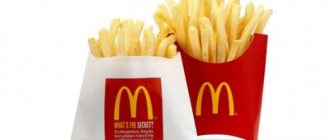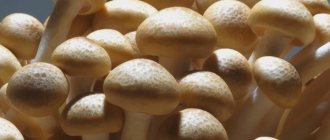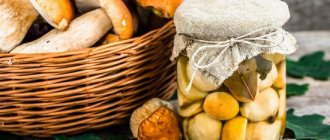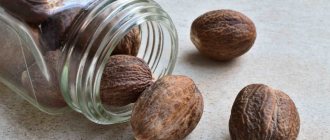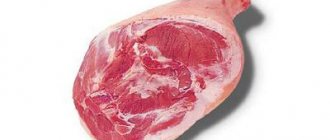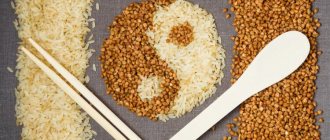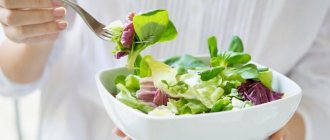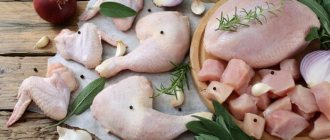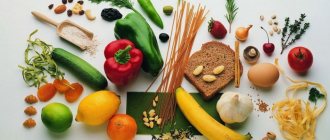When food enters the body, metabolic processes begin synchronously. These processes occur differently for each person. For some, calories are converted into energy, for others - into fat deposits. Why is that?
Everything is very simple:
- Firstly , each person has his own individual body with its own characteristics;
- Secondly , those who watch their figure compare the amount of energy received and consumed from food;
- Thirdly , the bodies of people who are prone to obesity process the food they receive into fat deposits.
The body processes food and converts it into energy. If a person does not use this energy in a timely manner, then this energy turns into fatty deposits on the human organs. In turn, these fat deposits become visually noticeable in the form of excess “fat” on the stomach, legs, and arms.
Negative calorie foods
People who decide to go on a diet usually have their priorities wrong. Some people have heard that there are foods that the body spends a lot of calories digesting. Not at all. After all, every product adds calories to the body to some extent, there are simply those that add more, and there are products whose calorie content is reduced to almost zero.
There are essentially no products with negative calories. But there are foods that do not overwhelm the human body with excess calories.
So, what is the list of foods with the minimum calorie level:
- Berries, for the most part, are oranges, grapefruit, lemon, blackberries, blueberries, currants, and also watermelon;
- Green tea is great to drink for those who want to reduce the level of calories in the body;
- Salads and greens are also low-calorie foods;
- Seasonings help remove calories from the body faster, unlike salt.
- Instead of sugar, it is recommended to use cinnamon.
Beet
This ubiquitous vegetable was originally found only in India. But thanks to trade caravans, the root crop reached the limits of the future of Russia. Since the times of Kievan Rus, the cuisine of the ancient Slavs was literally replete with beet dishes.
This vegetable is very healthy, it contains: a record amount of folic acid, magnesium, calcium, iron, manganese, zinc, iron, copper, molybdenum, cobalt, phosphorus, potassium, malic acid, citric, tartaric, oxalic acid, vitamins C, B, RR, A.
Despite the fact that beets have a calorie content of 49 kilocalories when boiled, people who want to lose weight should not consume this vegetable, as it contains a large amount of carbohydrates (about 10.8%).
What determines the calorie content of fresh fruits?
Often, fresh fruits become the main food product during diets. This is very correct, because fruits are healthy, tasty and, most importantly for a diet, low in calories. There are some peculiarities in choosing fruits for a diet, and simply for people who do not want to receive energy into the body, which they probably do not use.
So, how can you determine with the naked eye what the calorie content is in fruit? There are several methods.
For comparison and a clear example, let’s take a banana and a watermelon. Less calories in watermelon. You can also consider a couple of fruits like melon and grapes. Less calories in melon. The calorie content of fruit largely depends on its composition and consistency. The more liquid in the fruit, the lower the calorie content of this product.
The amount of sugar in the product also greatly affects the calorie level. That is, the sweeter the fruit treat, the more energy it will release into the body.
If we take specific examples, then dried fruits have much more calories than fresh fruits . From what was discussed above, it can be understood that this is due to a minimal amount of moisture in the product and an increased level of sugar. Although, if you do not take into account the calorie content, then dried fruits are very healthy and should be eaten in moderation.
https://youtu.be/https://www.youtube.com/watch?v=616VPWdoDKA
_
High and low calorie fruits
It is quite clear that there are high and low calorie foods. If you take into account fruits, they can be divided into low-calorie and high-calorie.
High and low calorie fruits:
| High calorie fruits | |
| Bananas | 89 calories |
| Nectarine | 63 calories |
| Kiwi | 61 calories |
| Mango | 60 calories |
You can add to this list all fruits that are similar in consistency and sweetness. But from the table it is easy to understand which fruit has the highest calorie content.
| Low calorie fruits | |
| Grapefruit | 32 calories |
| Papaya | 43 calories |
| Lemon | 29 calories |
| Plum | 46 calories |
Low-calorie fruits are quite enough; these are the fruits that need to be eaten and included in the diet.
Is low calorie content the most important indicator?
The dietary menu has its own nuances. Important indicators are the glycemic index (GI) and glycemic load (GL). They show how quickly carbohydrates are broken down and absorbed by the body. The lower the GI and GL, the fewer calories will be stored as extra pounds.
If we talk about vegetables, then among them you can find real enemies of a thin waist, for example, potatoes. And almost all fruits can surprise you with their sky-high sugar levels, since they all contain a fast source of carbohydrates - fructose.
There are two more factors that negate the benefits of fruits and vegetables:
The rate of energy breakdown from carbohydrates after heat treatment increases significantly
- .
The fact is that fiber is destroyed during cooking. Carbohydrates turn from complex to simple. And in order to process vegetables raw, the body spends more energy and, accordingly, calories.
Tip : It is better to eat vegetables raw. They completely retain vitamins and slowly saturate the body. The smaller you cut vegetables or fruits, the faster they are absorbed by the body.
When crushed, fiber, which slows down the breakdown of carbohydrates, is destroyed. This is especially true for making juices and smoothies. Some vegetables and almost all fruits become the worst enemies for health and figure.
Tip : Before eating, eat vegetables and fruits whole or cut into large pieces.
How many calories are in dried fruits?
Many people, in the process of losing weight and shedding extra pounds, due to inexperience, decide to eat as much dried fruit as possible, replacing sweets with them. In fact, of course, dried fruits are much healthier than many sweets. But you need to think about calorie content.
The level of calories in dried fruits is off the charts many times along with fresh fruits. Dried fruits are produced by drying fresh fruits. As a result of these actions, moisture and liquid are removed from the fruit, and sugar remains in high quantities.
How many calories are in dried fruits?
So the result is obvious. Dried fruits are acceptable to consume for health and saturation of the body. But not at all, not as a substitute for other products during a diet.
Jerusalem artichoke
Similar in chemical composition to potatoes, this vegetable contains quite a lot of sugars, including the polysaccharide inulin.
Jerusalem artichoke contains vitamins B, C, carotene, mineral salts, fructose.
The calorie content of Jerusalem artichoke is 61 kilocalories ; it is better not to be consumed by people who are overweight, since the large amount of carbohydrates (12%) contained in it can aggravate the situation. It is important to know that the increase in sugar content in the vegetable has a direct correlation with the shelf life of Jerusalem artichoke.
But, despite this fact, people with diabetes can not only use it, but also need it, since it contains valuable inulin, which is extremely useful for this disease.
Vegetable calorie table
In order to start a diet and start a new life with a thin waist, you need to create a clear diet for yourself. It is important to correctly prioritize and choose those foods that you like and contain a minimum amount of calories. Such a diet will not become a burden or complexity. After all, it is important that satiety is still present, and that energy is spent correctly.
There are many ready-made diets that have been compiled a long time ago and are popular. Such diets include all the necessary foods, vitamins and microelements. Well, if you decide to create your own nutrition schedule, then you will definitely need a table with the indicated caloric content level for each product.
So, you can choose your favorite vegetables using the calorie table:
| Vegetable name | Number of calories in product |
| Green pea | 72 calories |
| Potato | 80 calories |
| Avocado | 170 calories |
| Corn | 110 calories |
| Onion | 42 calories |
| Carrot | 38 calories |
| Radish | 35 calories |
| Parsley | 49 calories |
| Beet | 42 calories |
| Garlic | 45 calories |
| Brussels sprouts | 37 calories |
| Parsley root | 38 calories |
| Spinach | 16 calories |
| Green onions | 28 calories |
| Pumpkin | 25 calories |
| Tomatoes | 23 calories |
| Salad | 18 calories |
| Radish | 21 calories |
| Ground cucumbers | 14 calories |
| Chinese cabbage | 16 calories |
Purple color – foods with maximum calorie content;
Turquoise color – average calorie content of vegetables;
Light green color – minimum calorie content.
Based on this table, you can select those foods that should be present in your daily diet.
https://youtu.be/https://www.youtube.com/watch?v=DaL4GzlO024
_
Corn
Tasty and filling, corn is high in carbohydrates and sugars, which is extremely undesirable for obese people.
The calorie content of boiled corn is 110 kilocalories , the calorie content of canned corn is already 120 kilocalories .
Corn or maize is native to South America. It is interesting that at the dawn of their selection, wild varieties of corn had small cobs, about 3-4 centimeters.
Corn is saturated with the following beneficial microelements: vitamins A, B, C, iron, magnesium, potassium, and essential amino acids.
Carbohydrates in corn occupy about 60% of its total composition. This fact, as well as the presence of a significant amount of monosaccharides, disaccharides, dextrose, sucrose and fructose, explains the increased calorie content of the vegetable.
Fruit calorie table
To create a proper nutrition schedule, you also need to know what the calorie content of fruits is. After all, fruits are beneficial and help saturate the body with vitamins and essential microelements.
So, let’s take into account the most popular fruits that the average person often consumes:
| Fruit name | Number of calories in fruit |
| Banana | 89 calories |
| Grape | 65 calories |
| Mango | 67 calories |
| Persimmon | 53 calories |
| A pineapple | 49 calories |
| Cherry | 52 calories |
| Pomegranate | 52 calories |
| Kiwi | 51 calories |
| Raspberries | 42 calories |
| Peach | 42 calories |
| Pear | 42 calories |
| Orange | 38 calories |
| Watermelon | 38 calories |
| Blueberry | 35 calories |
| Strawberry | 34 calories |
| Cranberry | 26 calories |
| Blackberry | 31 calories |
| Apple | 37 calories |
Fruits with the highest calorie content are marked in red in the table. The turquoise color shows foods that are of average calorie content. Below the purple color are the fruits with the lowest calorie content. As can be seen from the table, a fairly large number of fruits contain a high level of calorie content. That is why, when giving preference to losing weight with a fruit diet, it is necessary to choose the right product.
The most important thing is to know how many calories you need to consume daily. Depending on the lifestyle a person leads, it is necessary to calculate the number of calories needed for a full life.
Top 5 most high-calorie fruits
The following fruits are considered the most nutritious:
Avocado
100 g of avocado contains 180 kcal. In addition, the fruit contains many useful substances that have a general strengthening effect. Thanks to vitamins E and F, the fruit has antioxidant properties. Avocado normalizes intestinal function, strengthens the cardiovascular system, and reduces the risk of stroke. The fruits are often added to vegetable salads.
Banana
100 g of fresh product contains 100-110 kcal. And in dried form, this figure increases to 390 kcal. Despite the high calorie content, the fruits of this fruit have a low glycemic index - 60. Therefore, bananas are recommended for consumption by patients with diabetes. The fruit contains a large amount of potassium, which is beneficial for normal heart function. Bananas have a beneficial effect on the functioning of the gastrointestinal organs, improve memory, increase body tone and elevate mood.
Grape
100 g of fresh product contains 75 kcal. 100 g of raisins – 265 kcal. It has a diuretic, bactericidal and laxative effect. The fruit promotes the production of enzymes that improve digestion. Due to the chemical elements it contains, grapes have a positive effect on the nervous system, reduce cholesterol levels in the blood, and help combat insomnia.
Mango
100 g of fresh product contains 67 kcal. This is due to the content of large amounts of glucose and sucrose. The fruit also contains iron, phosphorus and amino acids. It is the record holder among fruits for the amount of fiber. This means that mango promotes normal bowel function, cleanses it, helps get rid of constipation, and increases the level of hemoglobin in the blood. The presence of organic acids has a rejuvenating effect on the body as a whole.
Persimmon
100 g of fresh product contains 62 kcal. The fruits are distinguished by a high content of pectin. Potassium and magnesium contained in the composition prevent the growth and development of cancer cells. When coughing, it is recommended to eat persimmon to thin phlegm and cleanse the lungs. Strengthening the human immune system is facilitated by the high content of vitamin C, which in turn helps the body fight germs and viruses.
Chickpeas
Chickpeas or Turkish peas are widespread in the Middle East; in these countries there are many recipes based on them.
Chickpeas have a fairly high calorie content - 127 kilocalories per 100 grams when boiled . Naturally, with different cooking methods, its calorie content may increase.
In addition to being highly nutritious, chickpeas have a number of useful substances: polyunsaturated fats, vitamins A, C, E, B, K, potassium, magnesium, phosphorus, calcium, sodium, selenium, iron, zinc.
Lentils
This ancient culture, known from many historical treatises, is very nutritious. This is due to its composition, high content of proteins and carbohydrates.
A bowl of lentil soup will not only quickly satisfy your hunger, but will also give the body its daily requirement of folic acid.
In addition, lentils contain: vitamins E, PP, B, A, potassium, magnesium, zinc, calcium, iron, sodium, silicon, phosphorus, amino acids that are the most valuable for the body.
The significant content of carbohydrates and starch explains the high calorie content - 110 kilocalories .
What are high-calorie foods?
The most nutritious foods are fast food and desserts. These are dishes in which a lot of oils and fats are added during production, most often cheap and harmful. Such products allow you to quickly gain weight, but they are not suitable for children's menus. Adults are also not recommended to switch to such a diet, since it can significantly worsen their health.
After desserts and fast food come meat, fish, nuts, cereals, canned food, oils and sausages. Drinks are not among the top nutritious foods, but can cause sudden weight gain if consumed in large quantities.
Beans
The homeland of beans is Latin America. The composition explains the satiety of food prepared from beans; it includes a large amount of proteins and carbohydrates (24 g and 60 g of the total).
The calorie content of boiled beans is 123 kilocalories per 100 grams . Beans contain large amounts of important amino acids, pantothenic acid, folacin, calcium, iron, magnesium, zinc, ascorbic acid and provitamin A.
